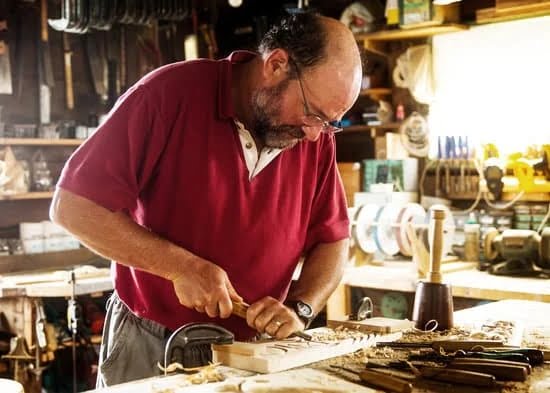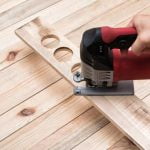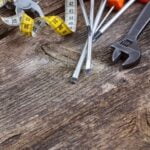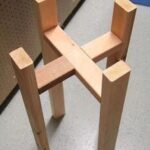Does your dog have a wood-chewing habit that drives you crazy? This article will provide effective solutions on how to keep dogs from chewing woodwork. It’s a common problem among dog owners, and the potential damage and safety hazards it can cause are significant. Understanding the root cause of this behavior is essential before attempting to change it. This article promises to offer insight into the reasons why dogs chew wood and effective solutions for dog owners.
Chewing on woodwork is a behavior that can be frustrating and destructive for both dogs and their owners. Understanding why dogs engage in this behavior is crucial in finding effective solutions. Additionally, providing proper dental care, ensuring regular exercise and mental stimulation, offering appropriate chew toys and treats, positive reinforcement training, environmental management, and seeking professional help are all valuable aspects to consider when addressing this issue.
Dog owners must be equipped with the knowledge and tools necessary to address their dog’s wood-chewing habits. This article aims to provide invaluable information and practical tips that can help create a chew-free environment for both you and your beloved pet. So let’s dive into the root causes of this behavior and explore effective strategies to prevent it.
Understanding the Root Cause of Chewing
When dogs engage in destructive behaviors like chewing on woodwork, it can be frustrating for pet owners. However, it’s important to understand the root cause of this behavior before attempting to address it. By understanding why dogs chew on woodwork, pet owners can effectively implement strategies to prevent this destructive habit.
Reasons Behind Chewing
There are several reasons why dogs may chew on woodwork. It can be a result of teething in puppies, anxiety or stress, boredom, or even a lack of appropriate chew toys. Some dogs may also exhibit this behavior as a way to seek attention from their owners. Understanding the specific reason behind the chewing behavior is crucial in devising a proper plan to address it.
Motivation for Chewing
In addition to understanding the reasons behind chewing, it’s important for pet owners to recognize the motivations driving this behavior. Dogs may derive pleasure from the act of chewing itself, find relief from teething discomfort, or even use chewing as a way to self-soothe when feeling anxious. By recognizing these motivations, pet owners can then take steps to redirect their dog’s behavior towards more appropriate outlets for these needs.
Behavior Modification
Once you have an understanding of why your dog is chewing on woodwork, you can begin implementing techniques for behavior modification. Whether it involves providing proper dental care and appropriate chew toys, ensuring adequate exercise and mental stimulation, utilizing positive reinforcement and training methods, managing your dog’s environment effectively, or seeking professional help when necessary – addressing the root cause of the problem through informed and targeted approaches is essential in effectively keeping dogs from chewing woodwork.
Providing Proper Dental Care
Proper dental care is vital for your dog’s overall health and can also play a significant role in preventing destructive chewing behavior, such as chewing on woodwork. Just like humans, dogs require regular dental hygiene to keep their teeth clean and healthy. Poor dental health can lead to discomfort, pain, and even the development of destructive habits like chewing on furniture. Therefore, it’s essential for dog owners to prioritize their furry friend’s dental care.
One way to ensure proper dental care for your dog is by implementing a regular teeth cleaning routine. This can involve brushing your dog’s teeth with toothpaste specifically formulated for canine oral hygiene. Additionally, providing your dog with dental chews or toys designed to promote good oral health can be beneficial in preventing plaque buildup and reducing the urge to chew on woodwork.
In addition to regular cleaning and the use of dental chews or toys, it’s also important to have your veterinarian conduct routine dental check-ups for your dog. Professional dental cleanings may be necessary to address any underlying issues that could be causing discomfort and driving the destructive chewing behavior.
When a dog’s teeth are healthy and pain-free, they are less likely to engage in behaviors that could potentially harm them or damage your home. By prioritizing proper dental care for your dog, you can effectively reduce the urge for them to chew on woodwork while promoting their overall well-being.
Exercise and Mental Stimulation
Dogs, like humans, need regular exercise to maintain their physical and mental well-being. When dogs don’t get enough physical activity or mental stimulation, they can become bored and may resort to destructive behaviors such as chewing on woodwork. Here are some tips for keeping your dog active and engaged:
- Daily walks: Taking your dog for regular walks is essential for providing them with the physical exercise they need. Aim for at least 30 minutes to an hour of walking each day, depending on your dog’s breed and energy level.
- Interactive toys: Invest in interactive toys that require your dog to work for treats or engage in problem-solving activities. These toys not only provide mental stimulation but also help redirect chewing behavior towards appropriate objects.
- Obedience training: Engaging your dog in obedience training sessions not only teaches them basic commands but also provides mental stimulation. Training sessions can be a fun way to challenge your dog’s intellect and keep them focused on positive behaviors.
- Dog sports: Consider enrolling your dog in agility, flyball, or other canine sports that provide both physical exercise and mental stimulation. These activities can be a great way for dogs to burn off excess energy while having fun.
By incorporating these strategies into your daily routine, you can help prevent boredom-related chewing behaviors in your dog. Remember that every dog is unique, so it’s important to find activities that best suit your furry friend’s individual needs and preferences.
Overall, providing adequate exercise and mental stimulation is key to keeping dogs from chewing woodwork. By fulfilling their physical and psychological needs, you can help curb destructive behaviors and create a happy, fulfilled canine companion.
Remember that a tired dog is a good dog.
Appropriate Chew Toys and Treats
When it comes to preventing dogs from chewing on woodwork, providing them with appropriate chew toys and treats can be a game-changer. This section will discuss the importance of selecting the right toys and treats for your furry friend and how these items can help redirect their chewing behavior.
Recommendations for Safe and Durable Chew Toys
Not all chew toys are created equal, and it’s essential to choose options that are safe and durable for your dog. Look for toys made from sturdy materials that can withstand heavy chewing, such as rubber or nylon.
Avoid toys that can easily splinter or break apart, as these could pose a choking hazard to your pet. Additionally, consider the size of the toy in relation to your dog’s breed and size to ensure it’s appropriate for them.
Benefits of Using Treats and Toys to Redirect Chewing Behavior
Using treats and toys as a distraction or redirection technique is an effective way to discourage wood-chewing behavior in dogs. When you notice your dog gravitating towards woodwork, offer them a safe chew toy or treat to shift their focus away from the furniture. Over time, they will learn that chewing on appropriate items like toys and treats is rewarding, while wood pieces are off-limits.
Finding the Right Chew Toys for Your Specific Dog
Every dog has different preferences when it comes to chew toys, so it may require some trial and error to find the right ones for your pet. Some dogs enjoy soft plush toys, while others prefer harder textures for chewing. Pay attention to what types of toys keep your dog engaged and satisfied, and rotate them regularly to keep things interesting. By finding the right chew toys for your specific dog, you can effectively deter them from damaging your woodwork.
Positive Reinforcement and Training
Dogs are naturally inclined to chew as it is a way for them to explore their surroundings and alleviate stress or boredom. However, when this behavior is directed towards woodwork, it can cause extensive damage to furniture, moldings, and other wooden structures in the home. Training your dog to avoid chewing on woodwork requires patience, consistency, and positive reinforcement.
Positive reinforcement is a powerful tool in training dogs to modify their behavior. This method involves rewarding desirable actions or behaviors with treats, praise, or toys. When it comes to preventing dogs from chewing woodwork, positive reinforcement can be used to redirect their attention to appropriate chew toys and discourage them from engaging with wooden objects.
One effective technique is to offer an alternative such as a durable chew toy whenever you catch your dog showing interest in woodwork. When they choose the toy over the wood, be sure to reward them with praise or treats. Consistency is key in this training method – every time you redirect your dog away from woodwork and reward their good behavior, you are reinforcing the message that chewing on wood is not acceptable while promoting positive habits.
In addition to positive reinforcement, it’s important to incorporate basic obedience training into your efforts to deter chewing behavior. Teaching commands such as “leave it” or “drop it” can help you effectively communicate with your dog when they are displaying unwanted behavior. With consistent practice and patience, these commands can be valuable tools in preventing destructive chewing habits.
| Training Method | Effectiveness |
|---|---|
| Positive Reinforcement | Highly Effective |
| Obedience Training | Valuable Tool |
Environmental Management
When it comes to preventing dogs from chewing woodwork, environmental management plays a crucial role in ensuring a safe and dog-friendly living space. By implementing certain strategies and utilizing the right tools, dog owners can effectively protect their woodwork from destructive chewing behavior. Here are some tips on how to keep dogs from chewing woodwork through environmental management:
- Use deterrent sprays: There are various deterrent sprays available on the market that are specifically designed to discourage dogs from chewing on furniture and woodwork. These sprays typically have a bitter taste that repels dogs when applied to the surface of the wood.
- Install barriers: If there are specific areas of the home where the dog tends to chew, consider installing barriers such as baby gates or pet gates to restrict access to those areas. This can prevent the dog from reaching the woodwork and engaging in destructive chewing behavior.
- Provide alternative chew surfaces: In addition to applying deterrent sprays and using barriers, it’s important to provide alternative chew surfaces for your dog. Invest in durable chew toys and encourage your dog to redirect its chewing behavior onto these appropriate items.
In addition to these strategies, it’s also important to create a safe and comfortable environment for your dog. Make sure your pet has access to its own designated space with proper bedding, toys, and entertainment. By managing the environment effectively, you can significantly reduce the risk of your dog damaging woodwork through chewing.
Overall, environmental management is an essential component of preventing dogs from chewing woodwork. By utilizing deterrent sprays, installing barriers, providing alternative chew surfaces, and creating a comfortable living space for your pet, you can effectively protect your woodwork from destructive chewing behavior while keeping your dog safe and happy.
Seeking Professional Help
When dealing with persistent chewing behavior in dogs, seeking professional help may become a necessary step for some pet owners. If your dog continues to exhibit destructive chewing habits despite your best efforts, consulting with a professional trainer or animal behaviorist can provide valuable insight and guidance. These experts have the knowledge and experience to assess your dog’s behavior, identify the root cause of the chewing, and create a customized training plan to address it.
Professional trainers and behaviorists can offer individualized solutions tailored to your dog’s specific needs. They can help you understand the underlying reasons for your dog’s destructive behavior, whether it’s due to anxiety, boredom, or other behavioral issues. By working closely with a professional, you can gain a deeper understanding of your dog’s behavior and learn effective techniques for modifying it.
When searching for a professional to help with your dog’s chewing issues, it is important to find someone who has experience working with similar cases. Look for trainers or behaviorists who use positive reinforcement-based methods and have obtained certification from reputable organizations such as the Certification Council for Professional Dog Trainers (CCPDT) or the International Association of Animal Behavior Consultants (IAABC).
It is essential to remember that seeking professional help does not reflect negatively on you as a pet owner. Instead, it demonstrates your commitment to addressing your dog’s behavioral challenges effectively. With the expertise and support of a qualified professional, you can work towards creating a chew-free environment and ensuring the well-being of both your dog and your home.
| Professional Help | Key Points |
|---|---|
| Expert Insight | Gain valuable insight into your dog’s behavior from professionals |
| Customized Solutions | Receive individualized training plans tailored to your dog’s specific needs |
| Certified Professionals | Look for trainers certified by reputable organizations such as CCPDT or IAABC |
Conclusion
In conclusion, the problem of dogs chewing on woodwork can be a frustrating and potentially damaging issue for many dog owners. However, by understanding the root cause of chewing behavior and implementing the right strategies, it is possible to prevent this destructive habit. Providing proper dental care, regular exercise, mental stimulation, appropriate chew toys and treats, positive reinforcement and training, environmental management, and seeking professional help when necessary are all effective solutions for addressing this common problem.
By ensuring that your dog’s dental health is maintained through regular cleaning and check-ups, you can reduce the urge for them to engage in destructive chewing. Additionally, providing adequate exercise and mental stimulation will keep your dog engaged and less likely to resort to chewing out of boredom or excess energy. Offering appropriate chew toys and treats can redirect their chewing behavior towards more acceptable outlets.
Positive reinforcement and consistent training also play a crucial role in preventing woodwork chewing by teaching your dog what behavior is expected. Environmental management techniques such as using barriers or deterrent sprays can help protect woodwork from being targeted by your dog. And finally, seeking professional help from trainers or behaviorists can provide additional support in addressing persistent chewing behavior.
In closing, it is important for dog owners to take action in implementing these suggested solutions to create a chew-free home environment. By prioritizing their pet’s dental health, physical and mental well-being, providing appropriate training and environmental management, dogs can be discouraged from engaging in destructive chewing habits.
It may require patience and consistency but the effort put into understanding the root cause of chewing behavior will lead to a happier coexistence between dogs and their owners in their shared living spaces.
Frequently Asked Questions
What Can I Put on Wood to Stop My Dog From Chewing?
You can put bitter apple spray or a similar pet deterrent on wood to stop your dog from chewing. This type of product has a taste that dogs don’t like, so it can discourage them from gnawing on the wood.
Why Does My Dog Chew My Woodwork?
Dogs may chew on woodwork out of boredom, anxiety, or teething. It’s important to determine the underlying cause of your dog’s behavior in order to address it effectively. Providing plenty of toys, exercise, and mental stimulation can help curb destructive chewing.
What Can I Put on Walls to Stop Dog Chewing?
To stop your dog from chewing on walls, you can try using bitter apple spray or a pet-safe deterrent product. Additionally, providing appropriate chew toys and engaging in regular training and exercise with your dog can help redirect their chewing behavior away from the walls.

Hi everyone! I’m a woodworker and blogger, and this is my woodworking blog. In my blog, I share tips and tricks for woodworkers of all skill levels, as well as project ideas that you can try yourself.





